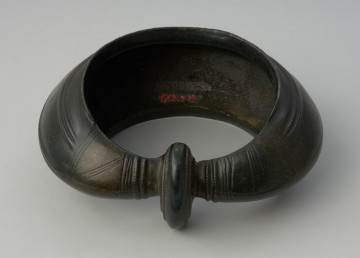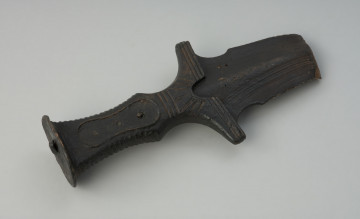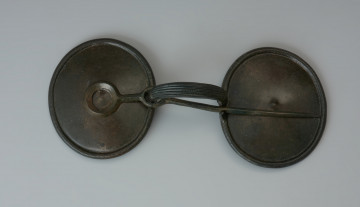
A cashew bracelet
around 600 p.n.e. — 400 p.n.e.
National Museum in Szczecin
Part of the collection: Bronze Age
The rim is made of a solid brown rod. The upper surface is covered with a very original motif of transverse ribbing. This impressive necklace is not complete; it is missing a small final piece. It is a virtually unique find. A similar piece is known only from one village in Greater Poland. The hoop was discovered in a hoard trove containing other very interesting ornaments in the middle of the 19th century. In 1933, Mr von Grünberg donated the entire find to the collection of the museum in Szczecin. He claimed that the bronzes had been in his family for many decades. In 1934, an article was published, in which it was first written that ... rarity of forms, good state of preservation and high-quality craftsmanship, allows the discovery from Wąsosz to be counted among the most extraordinary Pomeranian hoards ... In 1944, amid the threat of Allied air raids, the deposit was transported from Szczecin deep into Germany. The find, dated to the Hallstatt period D (c. 600/550-400/450 BC), only returned to the Szczecin collections in 2009 due to the Polish-German exchange of old archaeological collections. In 2012 it was published in an illustrated occasional catalogue entitled "Zaginione–Ocalone. Szczecińska kolekcja starożytności pomorskich" ("Lost-Saved. The Pomeranian Antiquities Collection of Szczecin").
Dorota Kozłowska
Author / creator
Dimensions
the entire object: height: 1 cm, diameter: 19 cm
Object type
necklace, bangle (hoop), body adornment
Technique
broaching
Material
bronze
Origin / acquisition method
legal transfer
Creation time / dating
Creation / finding place
Owner
National Museum in Szczecin
Identification number
Location / status

around 600 p.n.e. — 400 p.n.e.
National Museum in Szczecin

around 900 p.n.e. — 750 p.n.e.
National Museum in Szczecin

around 1000 p.n.e. — 900 p.n.e.
National Museum in Szczecin
DISCOVER this TOPIC
Museum of King Jan III's Palace at Wilanów
DISCOVER this PATH
Educational path